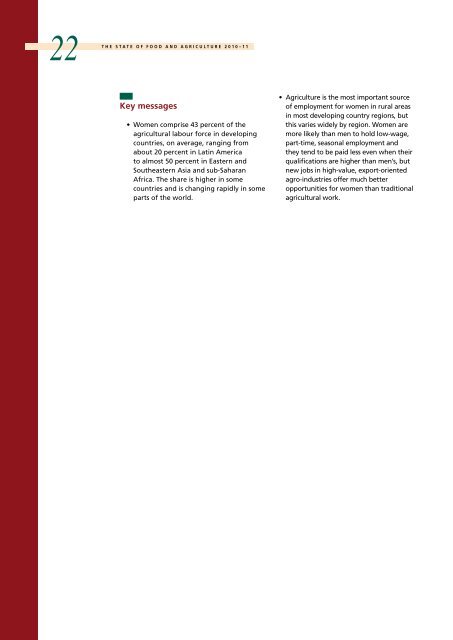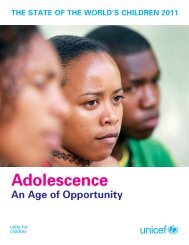The State of Food and Agriculture 2010-11: Women in ... - FAO
The State of Food and Agriculture 2010-11: Women in ... - FAO
The State of Food and Agriculture 2010-11: Women in ... - FAO
You also want an ePaper? Increase the reach of your titles
YUMPU automatically turns print PDFs into web optimized ePapers that Google loves.
22<br />
T H E S t a t E O F F O O D A N D A G R I C U L T U R E 2 0 1 0 – 1 1<br />
Key messages<br />
• <strong>Women</strong> comprise 43 percent <strong>of</strong> the<br />
agricultural labour force <strong>in</strong> develop<strong>in</strong>g<br />
countries, on average, rang<strong>in</strong>g from<br />
about 20 percent <strong>in</strong> Lat<strong>in</strong> America<br />
to almost 50 percent <strong>in</strong> Eastern <strong>and</strong><br />
Southeastern Asia <strong>and</strong> sub-Saharan<br />
Africa. <strong>The</strong> share is higher <strong>in</strong> some<br />
countries <strong>and</strong> is chang<strong>in</strong>g rapidly <strong>in</strong> some<br />
parts <strong>of</strong> the world.<br />
• <strong>Agriculture</strong> is the most important source<br />
<strong>of</strong> employment for women <strong>in</strong> rural areas<br />
<strong>in</strong> most develop<strong>in</strong>g country regions, but<br />
this varies widely by region. <strong>Women</strong> are<br />
more likely than men to hold low-wage,<br />
part-time, seasonal employment <strong>and</strong><br />
they tend to be paid less even when their<br />
qualifications are higher than men’s, but<br />
new jobs <strong>in</strong> high-value, export-oriented<br />
agro-<strong>in</strong>dustries <strong>of</strong>fer much better<br />
opportunities for women than traditional<br />
agricultural work.
















